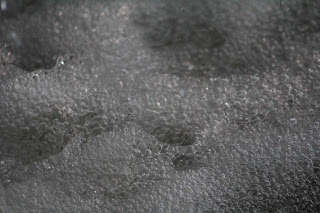Photo Terms
ISO-Film speed (the measure of a
photographic film's sensitivity to light) is designated by a single, almost
universally-accepted common system developed by the International Organization
for Standardization which uses the initials “ISO” before the film-speed
numbe.The ISO setting refers to the film speed of your camera. Higher
ISOs are used when it is darker outside and make the picture appear more
grainly. Lower ISOs are used when it is very sunny outside and are better
quality pictures. ISO's generally start at 100 and end at number around
6400.
Example: The following picture, taken of fast moving water was
taken at an ISO Speed of 6400.
Depth of Field- The depth of field deals with
the focus of the camera. Pictures that are taken close up and have a very
blurry background have a small depth of field, where landscape pictures
generally have a wide depth of field, as the entire picture is usually in
focus. Depth of field is controlled by the lens aperture, and extends
for a distance in front of and behind the point on which the lens is focused.
The higher the aperture, the whole picture is in focus. The lower the aperture,
the background will be blurred. If you take pictures close, you’ll have a small
depth of field. If you take pictures far away, you’ll have a large depth of
field. Pictures taken with telephoto lenses have a small depth of field
Example: The follow picture was taken with a small depth of
field
Light Meter- The light
meter shows you how much light is being let into your camera and tells you if
you need to change the shutter speed or the aperture. The light meter
helps you to make sure that the image you are taking a picture of has the right
exposure. If you want your picture to be brighter, you change the light meter
to + numbers. If you want your picture to be darker, you change the light meter
to – numbers.
-Two different settings: one for pictures taken w/out
flash, and another when using the flash The light meter can also give the
perfect light for a good picture
Example: the following 2 pictures taken with the sun in
front of me show the effect light meter can have. On jades image I lowered my
light meter to -1.
Diaphragm- A ring or plate
with a hole in the center that controls the amount of light entering the
camera. An adjustable diaphragm in a lens controls the size of the hole, or
aperture, thereby permitting more or less light to pass through the lens to the
film. The Diaphragm of the camera is an opening that lets a certain amount
of light into your camera. The smaller the diaphragm, the less light is
let into the camera. Small diaphragms are used when it is bright, and
larger ones are used when it is dark. This also directly relates to
aperture, as small diaphragms have large apertures and large diaphragms have
small apertures.
Aperture- Relates to the diaphragm and controls how much light is
let into the camera. Small aperture=more light, large aperture=less
light.
Kelvin Degrees- with Kelvin Degree you can change
the setting based on what type of light you’re in. 5200 degrees is normal light.
Tungsten light is 3200 degrees. The higher the degrees are, the bluer the
picture is. All visible light has a certain Kelvin temperature that can be
changed on a camera. The color of an image depends on the Kelvin Degrees of the
light emitted from that object. You can adjust the settings to change how
the light in your photo looks, making it more blue yellow or red.
By: Alfredo Muskus- Fall 2010





No comments:
Post a Comment